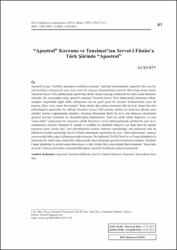“Apostrof” Kavramı ve Tanzimat’tan Servet-i Fünûn’a Türk Şiirinde “Apostrof”
Abstract
Apostrof, kısaca “özellikle duymayan varlıklara seslenme” şeklinde tanımlanabilir. Apostrof; ölü veya hayali bir kişiye, olmayan bir yere veya cansız bir nesneye, kişileştirilmiş soyut bir fikre hitap etmeye denir.Tanzimat öncesi Türk edebiyatında apostrofun direkt olarak karşılığı olabilecek bir edebî sanat bulunmamaktadır. Bu çalışmadaki amaç apostrof sanatının Tanzimat öncesi Türk edebiyatında kullanılıp kullanmadığını sorgulamak değil; farklı yaklaşımlar olsa da genel geçer bir tanımla “kişileştirilmiş soyut birkavram, ölüye veya cansız bir nesneye” hitap etmek olan anlamı üzerinden Batı’da Eski Yunan’dan berikullanılagelen apostrofun; bu şekliyle Tanzimat sonrası Türk şiirinde sıklıkla yer almasının altında yatansebepler üzerine yoğunlaşmak olacaktır. Tanzimat döneminde Batılı bir tavır olan dünyaya yönelmeninapostrof kavramı üzerinden de okunabileceğini düşünüyoruz. Tanrı’nın akılla idraki düşüncesi ve yeni“insan-tabiat” anlayışının bir yansıması olarak Tanzimat I. nesil edebiyatçılarında görülen bu yeni tavır;romantizmin etkisiyle Tanzimat II. nesilde ve özellikle de Abdülhak Hâmit’te çok daha bariz bir şekildekarşımıza çıkar. Ancak eski- yeni mücadelesinin yeninin zaferiyle sonuçlandığı, tam anlamıyla yeni biredebiyatın kendini gösterdiği Servet-i Fünûn döneminde apostrofun da yeni “Tanrı-tabiat-insan” anlayışıçerçevesinde daha yoğun kullanımına şahit oluyoruz. Bu bağlamda Tevfik Fikret’in ve Cenap Şahabettin’inşiirlerinde bir edebî sanat olarak Batı edebiyatında sıkça kullanılan apostrof örneklerine rastlanır. ÖzellikleCenap Şahabettin’in şiirleri onun tabiat algısı ve rûh-i kâinat fikri çerçevesinde Batılı anlamda “Tanrı-tabiat-insan” anlayışı üzerinden yorumlayabileceğimiz apostrof örneklerini çokça içermektedir. Apostrophe is addressing a dead or imaginary person, a nonexisting place or thing or a personalized abstract idea. There isn’t a lirerary art that corresponds apostrophe directly in Turkish Lierature before Tanzimat. The purpose of this study is not questioning if this art was used or not in Turkish Literature before Tanzimat but although there are different approaches based on the meaning of apostrophe which is addressing a personalised abstract concept, a dead person or an inanimate object; the purpose is to concentrate on reasons of apostrophe usage, that has been used in Western Literature since ancient Greek period in this way, in Turkish poetry after Tanzimat. We also think that turning onto the world, that is in a Western attitude in Tanzimat reform era ,can be examined on the apostrophe concept. As a reflection of the idea of realising God by wisdom and the reflection of the new human-nature intellection, this new attitude which is seen on Tanzimat 1st generation men of letters appears apparently on Tanzimat 2nd generation men of letters’ works and especially on literal Works of Abdülhak Hamit by impression of Romanticism. However we see that apostrophe is used more often within the frame of new Godnature-human intellection during Servet-i Fünûn period when a “new-old” struggle was ended by the victory of the “new” and a new literature was appeared exactly.ın this regard, in Tevfik Fikret and Cenap Şahabettin’s poems, we can see apostrophe examples that is often used in Western literature as a “literary art”. Especially the poems of Cenap Şahabettin contains apostrophe examples which can be interpreted on God-nature-human intellection in a Western content within the frame of his nature perception and the idea of the soul of nature.
Source
Dil ve Edebiyat AraştırmalarıVolume
19Issue
19URI
https://doi.org/10.30767/diledeara.542593https://app.trdizin.gov.tr/makale/TXpnMU5qZzBOQT09
https://hdl.handle.net/20.500.11857/2227



















